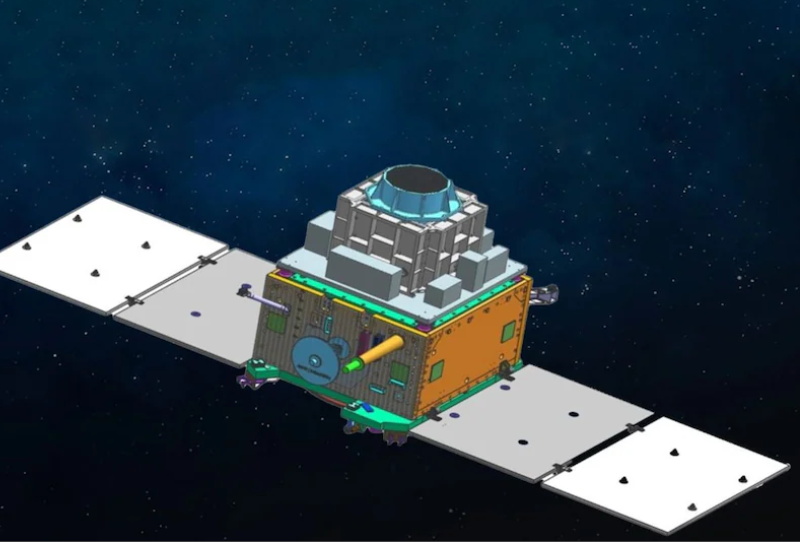India’s First X-ray Polarimetry Satellite Captures Supernova Remnant
The XSPECT instrument aboard India’s pioneering XPoSat space observatory has successfully acquired its first images of the Cassiopeia A supernova remnant. The achievement comes within days of the mission’s January 1 launch.
Introducing XPoSat
XPoSat is India’s maiden satellite dedicated to studying polarized and spectroscopic emissions in cosmic X-ray sources. Weighing less than 20 kgs, this compact spacecraft hosts two aligned scientific payloads in low Earth orbit – POLIX and XSPECT. Together, these instruments enable novel polarization and spectroscopic analyses of bright cosmic X-ray sources down to remarkable precision.
About POLIX
- POLIX is the primary instrument aboard XPoSat designed to measure X-ray polarization from cosmic sources.
- Developed jointly by the Ramam Research Institute and ISRO’s UR Rao Satellite Centre, the payload examines polarization parameters in the 8-30 keV medium energy range.
- It consists of an X-ray collimator, scatterer and four surrounding proportional counter detectors.
- The scatterer element comprises low atomic mass material enabling polarized X-rays to undergo anisotropic Thomson scattering.
- Meanwhile, the collimator restricts the field of view to a narrow 3×3 degrees allowing observations of primarily a single bright astronomical object.
- Over XPoSat’s planned 5-year mission duration, POLIX aims to study polarization across 40 exotic galactic and extragalactic X-ray sources spanning categories like pulsars, quasars and supernova remnants.
About XSPECT
- The XSPECT instrument aboard XPoSat facilitates both spectral and timing studies of soft X-ray emissions from exotic celestial objects.
- It harnesses the extended monitoring opportunities offered by the polarimetry-focused POLIX payload to examine long-term behavior patterns.
- Specifically, XSPECT can track gradual changes in spectral line intensities and profiles as well as fluctuations in broadband emissions over 0.8-15 keV energies.
- The payload achieves good spectroscopic resolution below 200 eV along with rapid variability mapping leveraging an array of advanced Swept Charge Detector arrays providing over 30 sq. cm collective area.
- Further background noise reduction occurs through narrow-field passive collimators.
- Targeted source categories include x-ray pulsars, black hole binaries, certain neutron stars, active galactic nuclei and magnetars.
- By synergizing with POLIX surveys, XSPECT aims to uncover intriguing physics behind observed flux variances across magnetized and high-energy environments in our dynamic cosmos.
First Light Achievement
As part of early orbit checks, the XSPECT payload imaged Cassiopeia A, a reference celestial object. The instrument captured the expanding shell of gas from the supernova explosion including signatures of constituent elements – a promising start.
About Cassiopeia A
- Cassiopeia A is the strongest radio wave source in the sky beyond our solar system, located around 11,000 light years from Earth in the Cassiopeia constellation.
- It is the remnant from a supernova generated by a massive collapsing star, with light from the explosion estimated to have reached Earth between 1662-1700 AD.
- Though the supernova blast was likely intense, there are no definitive historical sighting records except for a possible 1680 observation by astronomer John Flamsteed, indicating it may have occurred behind dense interstellar clouds.
- Today, the remnant is visible across radio, infrared and X-ray wavelengths, appearing as an expanding 5 arcminute wide ring, whose rate of expansion has revealed the approximate date of the supernova event.
- At Cassiopeia A’s core lies a neutron star confirmed as the first ever detected to have a carbon atmosphere composition.
Significance of Results
XPoSat’s unmatched observation capabilities in the niche X-ray polarimetry field can provide novel insights into exotic remnants, pulsars, black holes and more.
For instance, polarization signatures help unveil mechanisms driving extremely energetic cosmic gamma ray bursts.
Likewise, mapping elemental fingerprints sheds light on stellar evolution cycles.
Continuous data over XPoSat’s intended 5-year lifetime will enrich understanding across areas.
Month: Current Affairs - January, 2024
Category: Science & Technology Current Affairs






